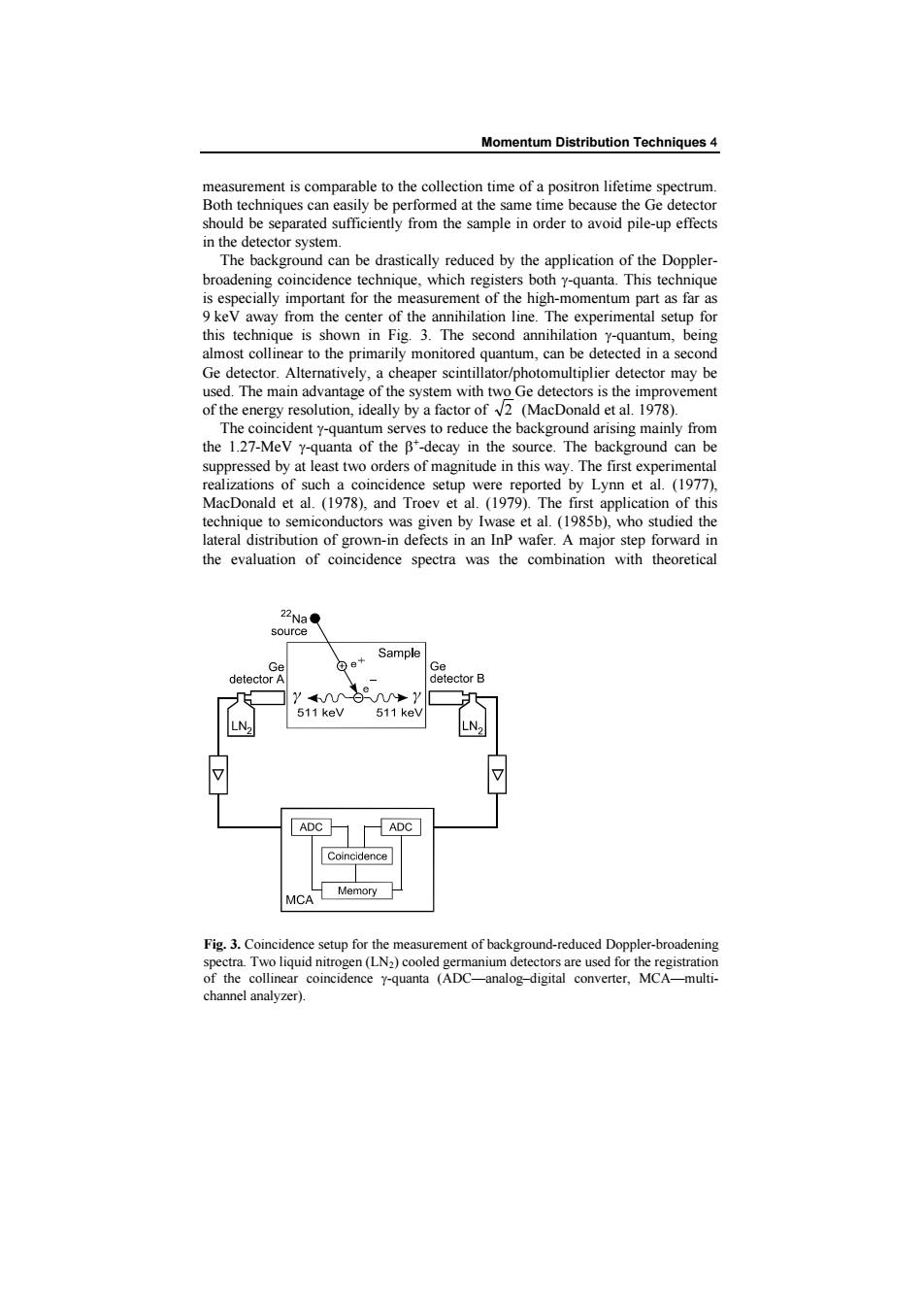正在加载图片...

Momentum Distribution Techniques 4 measurement is comparable to the collection time of a positron lifetime spectrum Both techniques can easily be performed at the same time because the Ge detector should be separated sufficiently from the sample in order to avoid pile-up effects in the detector system. The background can be drastically reduced by the application of the Doppler- broadening coincidence technique,which registers both y-quanta.This technique is especially important for the measurement of the high-momentum part as far as 9 keV away from the center of the annihilation line.The experimental setup for this technique is shown in Fig.3.The second annihilation y-quantum,being almost collinear to the primarily monitored quantum,can be detected in a second Ge detector.Alternatively,a cheaper scintillator/photomultiplier detector may be used.The main advantage of the system with two Ge detectors is the improvement of the energy resolution,ideally by a factor of2 (MacDonald et al.1978). The coincident y-quantum serves to reduce the background arising mainly from the 1.27-MeV y-quanta of the B*-decay in the source.The background can be suppressed by at least two orders of magnitude in this way.The first experimental realizations of such a coincidence setup were reported by Lynn et al.(1977). MacDonald et al.(1978),and Troev et al.(1979).The first application of this technique to semiconductors was given by Iwase et al.(1985b),who studied the lateral distribution of grown-in defects in an InP wafer.A major step forward in the evaluation of coincidence spectra was the combination with theoretical 22Na● source Sample Ge @日牛 Ge detector A detector B y4n白几y 511 keV 511 keV LN LN ADC ADC Coincidence Memory MCA Fig.3.Coincidence setup for the measurement of background-reduced Doppler-broadening spectra.Two liquid nitrogen(LN2)cooled germanium detectors are used for the registration of the collinear coincidence y-quanta (ADC-analog-digital converter,MCA-multi- channel analyzer).Momentum Distribution Techniques 4 measurement is comparable to the collection time of a positron lifetime spectrum. Both techniques can easily be performed at the same time because the Ge detector should be separated sufficiently from the sample in order to avoid pile-up effects in the detector system. The background can be drastically reduced by the application of the Dopplerbroadening coincidence technique, which registers both g-quanta. This technique is especially important for the measurement of the high-momentum part as far as 9 keV away from the center of the annihilation line. The experimental setup for this technique is shown in Fig. 3. The second annihilation g-quantum, being almost collinear to the primarily monitored quantum, can be detected in a second Ge detector. Alternatively, a cheaper scintillator/photomultiplier detector may be used. The main advantage of the system with two Ge detectors is the improvement of the energy resolution, ideally by a factor of 2 (MacDonald et al. 1978). The coincident g-quantum serves to reduce the background arising mainly from the 1.27-MeV g-quanta of the b + -decay in the source. The background can be suppressed by at least two orders of magnitude in this way. The first experimental realizations of such a coincidence setup were reported by Lynn et al. (1977), MacDonald et al. (1978), and Troev et al. (1979). The first application of this technique to semiconductors was given by Iwase et al. (1985b), who studied the lateral distribution of grown-in defects in an InP wafer. A major step forward in the evaluation of coincidence spectra was the combination with theoretical Fig. 3. Coincidence setup for the measurement of background-reduced Doppler-broadening spectra. Two liquid nitrogen (LN2 ) cooled germanium detectors are used for the registration of the collinear coincidence g-quanta (ADC—analog–digital converter, MCA—multichannel analyzer)